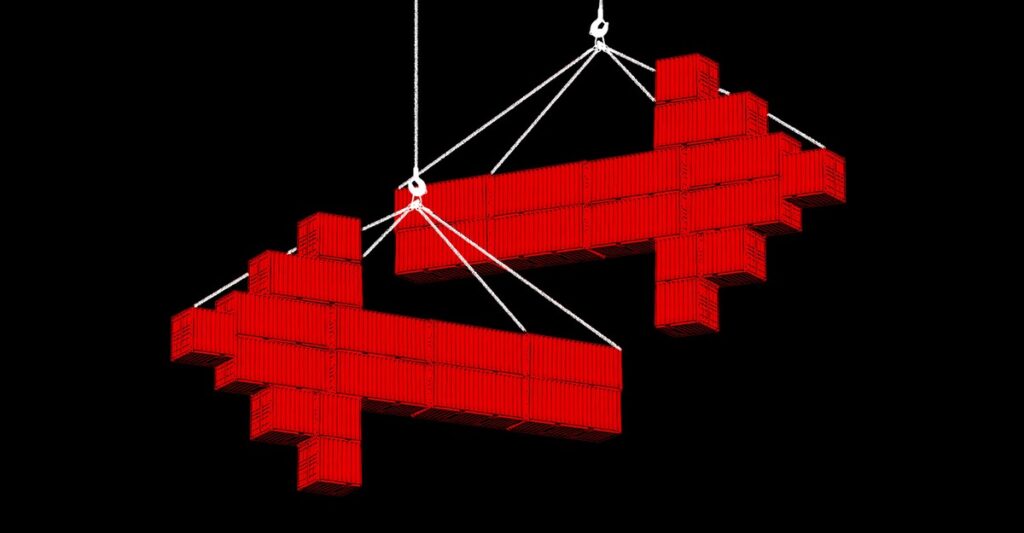According to President Donald Trump, April 2, 2025—the day he unveiled his executive order implementing global tariffs—will be remembered as a turning point in American history. He might be right. Unfortunately, April 2 is more likely to be remembered as a fiasco—alongside October 24, 1929 (the stock-market crash that kicked off the Great Depression), and September 15, 2008 (the collapse of Lehman Brothers)—than as the beginning of a new era of American prosperity.
The stated rationale behind Trump’s new “reciprocal tariffs” has a more coherent internal logic than Trump’s previous tariff maneuvers. (Stated, as we will see, is the key word.) The idea is that other countries have unfairly advantaged their own industries at the expense of America’s, both through tariffs and through methods such as currency manipulation and subsidies to domestic firms. To solve the problem, the U.S. will now tax imports from nearly every country on the planet, supposedly in proportion to the barriers that those countries place on American goods.
The goal, according to senior administration officials, is to pressure other countries into removing their trade barriers, at which point the U.S. will drop its own. In his Rose Garden speech announcing the tariff order, Trump demanded that foreign countries “terminate your own tariffs, drop your barriers,” and “don’t manipulate your currencies” if they hoped to get a reprieve from tariffs. Treasury Secretary Scott Bessent has even argued that many of the new tariffs won’t ever need to go into effect, because other countries will be so quick to comply. In this telling, Trump’s reciprocal measures represent the tariff to end all tariffs, paving the road to a system of genuinely free trade and a return to American industrial dominance.
But the logical consistency, such as it is, is only internal. When the new tariffs come into contact with external reality, they are likely to produce the exact opposite of the intended outcome.
Most obviously, the tariffs don’t appear to be based on actual trade barriers, which undermines their entire justification. Contrary to White House messaging, the formula for determining the new rates turns out to have been based simply on the dollar value of goods the U.S. imports from a given country relative to how much it exports. The administration took the difference between the two numbers, divided it by each country’s total exports, then divided that total in half, and slapped an import tax on countries at that rate. The theoretically reciprocal tariffs are not, in fact, reciprocal.
The result is that there is no clear or obvious path that countries could take to get those tariffs removed even if they wanted to. Countries can remove all of their trade restrictions and still run a trade surplus. South Korea, Mexico, and Canada, for example, export more to us than they import from us despite imposing virtually no trade barriers. As The New York Times reported, “Trump’s decision to put a 32 percent tariff on Switzerland stunned politicians and business leaders in the Alpine country. Switzerland has an open trade policy and recently abolished all industrial tariffs, including on goods from the United States, which is also its largest export market.”
Even if other countries did figure out ways to shrink their trade imbalances with the U.S., that still wouldn’t necessarily lead to a reprieve: Trump imposed 10 percent tariffs even on countries, like Brazil, that import more from America than they export to it. The only thing the White House has made clear is that any decision to remove or raise tariffs will be made by Trump himself. “These tariffs will remain in effect until such a time as President Trump determines that the threat posed by the trade deficit and underlying nonreciprocal treatment is satisfied, resolved, or mitigated,” read the White House’s memo on the new order. Translation: The only way you will get a tariff reprieve is by groveling at Trump’s feet.
To see the impossible choices that Trump’s tariffs impose on other countries, consider the trade restrictions that the administration accuses the European Union of maintaining against American products. These include food-safety regulations that ban certain ingredients, digital sales taxes, and the value-added tax—the European equivalent of a national sales tax that funds much of its members’ welfare programs. Calling most of these “trade barriers” in the first place is nonsensical, because they apply equally to foreign and domestic goods. The upshot is that, in order to meet Trump’s demands for tariff removal, Europe would need to overhaul not only its trade practices but much of its tax and regulatory system.
The best way to predict how countries will react to Trump’s newest tariffs is to look at how they responded to earlier ones. China and Europe quickly met past Trump tariffs with steep retaliatory measures of their own. Even in a friendly country as dependent on U.S. trade as Canada, Trump’s threats have generated a surge of anti-American nationalism that has upended the country’s domestic politics. “The idea that foreign leaders are going to commit political suicide to give Trump what he wants is crazy enough,” Scott Lincicome, the director of general economics and trade at the Cato Institute, told me. “The idea that they’d do it with basically no guaranteed upside just completely boggles the mind.”
Trump’s newest tariffs have already sparked widespread outrage among America’s trading partners. The head of the European Union has said that the body has a “strong plan to retaliate” against Trump’s reciprocal tariffs, and multiple individual European countries are considering their own additional retaliatory policies. France has floated the idea of expanding the trade war beyond physical goods by targeting U.S. tech companies. China vowed to take countermeasures against what it described as “self-defeating bullying.” Brazil’s president is considering retaliating, and the country’s National Congress, which includes many vocal right-wing supporters of Trump, recently approved legislation to empower him to do so.
If that pattern holds, Trump’s tariffs are likely to backfire. The result will be a one-way ratcheting up of tariffs across the globe, creating a trade wall between the U.S. and the rest of the world and indefinitely raising the cost of all imports.
Trump seems to welcome that possibility. During his Rose Garden address, which was titled “Make America Wealthy Again,” the president spoke at length about outcomes that are likely to occur only if the U.S. does not lower its tariffs, such as bringing in “trillions and trillions” of dollars of revenue and forcing companies to open factories inside the U.S. to avoid the new barriers. He sounded much more like someone who expected the tariffs to stay in place indefinitely than someone using them as a negotiating tactic.
In theory, the flip side of sustained higher prices would be a boost to American manufacturing, as consumers choose to purchase domestic goods over foreign ones. But here again, reality might laugh at the theory. About half of all U.S. imports are inputs that go into our own manufacturing production, meaning that American companies will suffer from higher prices too, even as retaliatory tariffs make it harder to sell their products abroad.
Perhaps the greatest damage will result from global uncertainty. After weeks of economic chaos, Trump’s big announcement was supposed to finally provide some clarity, allowing businesses to plan for the future. Instead, the future is more cloudy than ever. No one knows which of the tariffs will stick and which will be lifted. Countries will appeal to Trump to get their tariffs removed. Industries will lobby for carve-outs. The White House has announced no clear system for removing or reducing the tariffs, and even if it did, the ultimate choice will lie with the president himself, who is not known as a model of consistent and predictable decision making. These are the makings of an economic slowdown. “I would be shocked if we make it through next year without a recession,” Kimberly Clausing, an economist at the UCLA School of Law, told me.
What makes the new reciprocal tariffs all the more baffling is that a much less risky method exists to get other countries to agree to free trade. It is called a free-trade agreement. Trump ought to know. In his first term, his administration negotiated the United States–Mexico–Canada Agreement, or “New NAFTA,” which lowered trade barriers between America and its neighbors while requiring all parties to abide by higher labor and environmental standards. The Trans-Pacific Partnership, a trade deal negotiated by the Obama administration between the U.S. and 11 countries, including Vietnam, Japan, Singapore, and Malaysia, would have done something similar if Trump hadn’t pulled the U.S. out of the deal upon entering office in 2017. Those are some of the same countries that he is now trying to tariff into submission. He would have been better off remembering the art of the deal.
Premium IPTV Experience with line4k
Experience the ultimate entertainment with our premium IPTV service. Watch your favorite channels, movies, and sports events in stunning 4K quality. Enjoy seamless streaming with zero buffering and access to over 10,000+ channels worldwide.

















